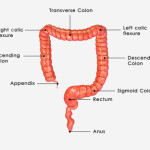As a physiotherapist and yoga instructor, I utilize manual therapy and yoga postures to treat pain and increase mobility. While yoga is an effective way to increase flexibility and strength, it also has many physiological benefits.
The large intestine is where the final stages of digestion take place. It includes the cecum, colon, and rectum. It begins at the inner right hip, ascends up the abdomen, across the abdominal cavity, then down the left side, towards the left hip, and down to the anus. The large intestine's function is to absorb water from the matter as it passes through and then to pass the waste material from the body.
The colon is often related to back and lower extremity pain. Various manual therapy techniques relieve restrictions in these areas. During an assessment and treatment, it can often be determined if these structures are related to restricted mobility and pain.
One yoga pose that is beneficial for both digestion and musculoskeletal pain is Pawanmuktasana or leg lock pose. This posture strengthens the core muscles and increases flexibility of the spinal vertebrae. It massages the digestive organs, thereby removing gas and relieving constipation. People with high blood pressure, sciatica, and disc herniation should not practise this pose.
To practise this pose, start by lying flat on your back with your toes pointing up. Bring the right thigh towards the chest, while keeping the straight leg in contact with the ground. Clasp the right shin with your hands. Inhale deeply. Exhale, raise the head and shoulders, and bring the right knee towards the nose. Hold this position for a few seconds. Slowly inhale while returning to the starting position.
Repeat 3 times with the right leg, then 3 times with the left. The right side is practised first, as it compresses the ascending colon, and the left compresses the descending colon, which is the order that matter travels through the digestive tract. The second part of this pose is practised by bringing both thighs into the chest and raising the head to try to place the nose in the space between the knees. This is also practised 3 times. If any discomfort is experienced as a result of this pose, the practice should be stopped.
Joanna Miller, Physiotherapist and Certified Yoga Teacher










